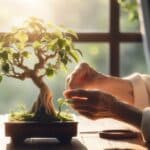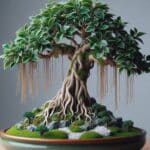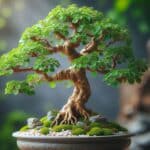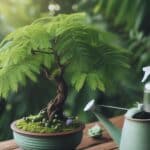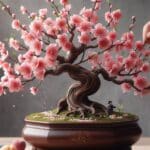When it comes to bonsai growing, there are countless species you can choose from to make an impact – but the willow leaf ficus bonsai is one you’ve got to consider.
This plant, which is a species of fig that has green leaves, a tall trunk, and a fondness for indoor growing, is also one of the easiest you can grow. Known for its elongated nature, this tree (Ficus nerifolia/salicifolia) looks much like a classic weeping willow tree.
Under extremely humid conditions and a dense tropical canopy, the tree will shed aerial roots that are characteristic of a tropical tree and can be used in a bonsai design.
Here’s everything you need to know about growing this unique specimen, also known as Mexicana ficus.
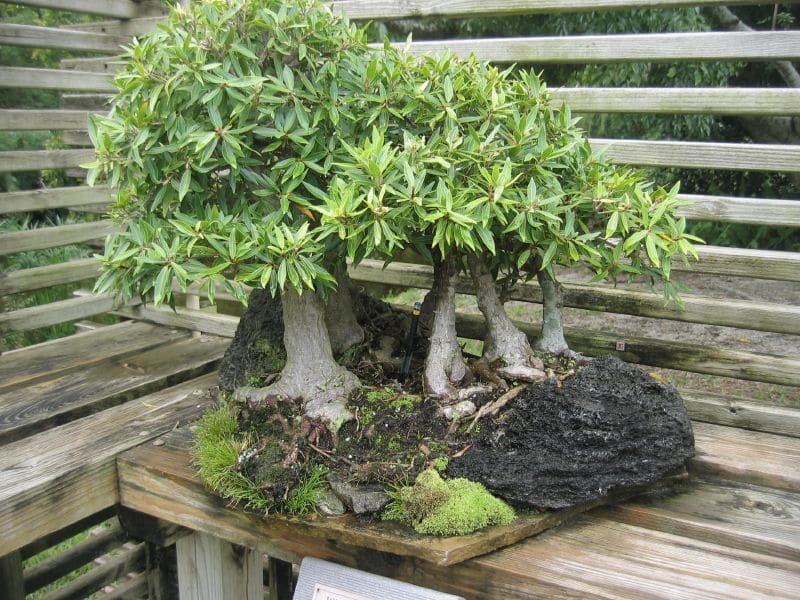
Interesting Facts about Willow Leaf Ficus
| Height | 8–11” |
| Width | 3-5” |
| Sunlight | Full direct light |
| Flowering Time Length | Does not flower in significant amounts |
| Lifespan | 100+ years |
| Scientific Name | Ficus nerifolia/salicifolia |
How to grow Willow Leaf Ficus
It’s best to purchase your willow leaf fig as a starter bonsai plant from a reputable nursery. However, it can also be started from seed (a lengthy process) or by propagation via cuttings taken from a mature plant.
How to Care for Willow Leaf Ficus
Here’s how to care for ficus nerifolia bonsai and ficus salicifolia bonsai trees:

Sunlight
The best placement for your willow leaf ficus bonsai will vary depending on the time of year. In the spring, summer, and fall, your tree will do best when placed in high lighting conditions.
They grow outside in full sun provided that temperatures remain above 45 degrees Fahrenheit all year in tropical locations and seldom go dormant. If it becomes warmer than this, bring your plant indoors and place it on a sunny windowsill.
In the winter, your ficus plant almost always will need to be brought indoors. The best location will be on a windowsill that faces the south – through a window with eastern or western exposure will also work. Your focus needs at least four to six hours of sunlight each day.
Watering
Be sure to water your willow leaf ficus each time the soil appears dry. Try to avoid letting the soil dry out completely. Water until it begins to trickle out of the drainage holes at the bottom of your planting container.
You may also want to provide some extra humidity for your plant, something that is especially important during the drier winter months. Consider placing your plant on a shallow tray filled with a layer of gravel. Pour water over the gravel. This will supplement the extra moisture your tree needs.
Fertilizing
If you want your indoor bonsai to remain healthy, you will also need to fertilize on a regular basis. You can use any balanced liquid fertilizer, but you will want to dilute it to half strength.
Potting and Repotting
You will need to periodically repot your willow leaf ficus, typically when the root system has filled the pot (generally this is about once every two to three years). This will allow you to provide your tree with fresh soil and will also encourage the roots of the tree to grow in a more compact fashion. The best time to report is in the summer.
Pruning Willow Leaf Ficus
Pruning and pinching your ficus bonsai plants is essential if you want it to grow in a desired fashion. This will also help your tree remain in a miniature form. Simply trim and pinch back new growth to the furthest safest point, but never remove all of the new growth – you should leave some to sustain the rest of the tree. Pinch and trim as needed.
Pests and Diseases
You can treat your willow leaf ficus bonsai for diseases and pests just as you would a full-sized tree. There are few diseases to which this plant is prone besides root rot and other fungal diseases (both of which can be prevented with proper watering) but you will want to watch out for pests like aphids, scale insects, and spider mites.
Where to Buy Willow Leaf Ficus
Technically, you can buy your bonsai tree from any dealer or nursery that specializes in this art. However, for best results, you should consider purchasing a plant that is already established and from a company backed by good customer reviews. Bonsai is simply the reproduction of trees in a miniature fashion – they are totally dependent on you for their proper care, since they are grown in pots.
Starting with a healthy tree is the best thing you can do to increase your odds of growing a healthy, thriving bonsai plant. With any luck, you’ll be able to grow a tree that lasts for decades!
FAQs
Which Ficus is best for bonsai?
The Ficus Retusa, commonly known as the Chinese Banyan or Ginseng Ficus, is often considered one of the best cultivars of other ficus species. Its small leaves, adaptability to different pruning styles, and overall hardiness make it a popular choice for both beginners and experienced bonsai enthusiasts.
What are the disadvantages of a ficus bonsai tree?
Ficus bonsai trees can be sensitive to environmental changes and are susceptible to pests like spider mites, requiring vigilant care to maintain their health.
Also check our guides about caring for Ficus Microcarpa Ginseng and Ficus Retusa Bonsai.
*A big thank you to Dr. Blaise Allen for letting us use the photos above!

